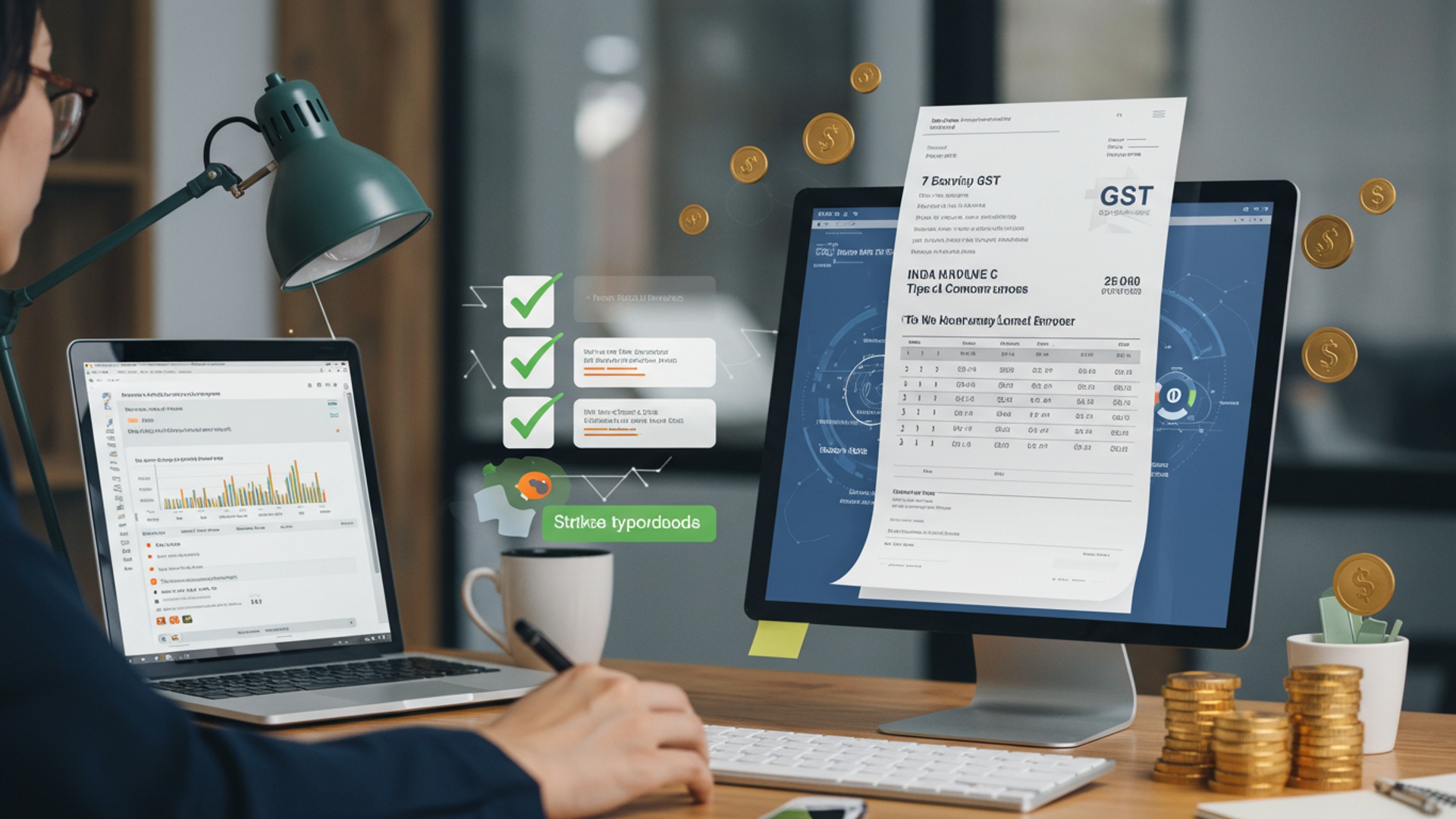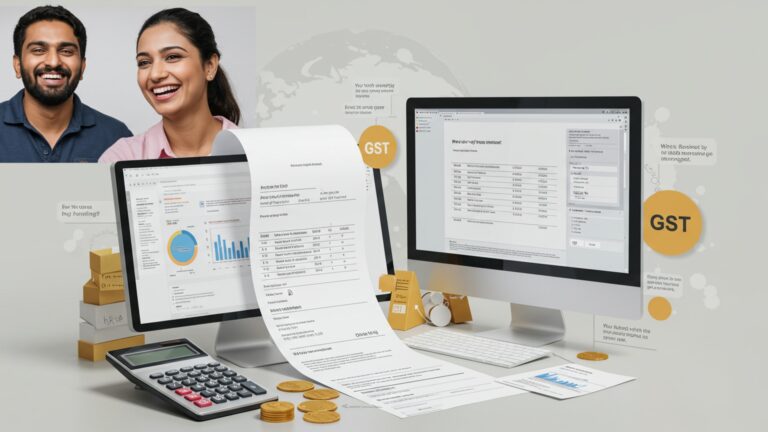Learn 7 Essential GST Invoicing Tips to Master Compliance and Avoid Common Errors
Navigating the intricate landscape of Goods and Services Tax demands meticulous attention to invoicing, where even minor omissions like an incorrect HSN code or a missing dynamic QR for B2C transactions can escalate into significant compliance headaches. With the recent expansion of e-invoicing mandates and intensified GST audit scrutiny, businesses face unprecedented pressure to ensure every invoice adheres to the latest regulations, avoiding costly penalties and input tax credit reversals. Mastering precise GST invoicing tips is no longer optional; it is a critical strategy for safeguarding your financial standing and ensuring seamless operations amidst evolving regulatory frameworks.

Understanding the Basics of GST Invoicing
Navigating the world of Goods and Services Tax (GST) can seem daunting, especially when it comes to invoicing. Yet, mastering your GST invoicing is not just about adhering to the law; it’s about ensuring smooth business operations, avoiding penalties. maintaining healthy financial records. For any business, from startups to established enterprises, an invoice isn’t just a bill – it’s a legal document that captures the essence of a transaction, detailing the goods sold or services rendered, along with the applicable taxes. Without accurate GST invoices, businesses risk compliance issues, delayed refunds. complications during audits.
At its core, a GST invoice is a commercial instrument issued by a supplier to a recipient, indicating the products, quantities. agreed prices for products or services. Crucially, it must also display the GST charged on the transaction. Compliance means strictly following the rules set forth by the GST law regarding the content, format. issuance of these invoices. Many businesses, particularly those new to the GST regime, often overlook critical details, leading to common errors that can be easily avoided by following effective GST invoicing tips.
Tip 1: Mandatory Fields – Don’t Miss a Single Detail
One of the most critical aspects of GST invoicing is ensuring that every mandatory field is accurately filled. Missing even one piece of details can render an invoice invalid, leading to potential input tax credit (ITC) issues for your recipient and compliance problems for you. Think of your invoice as a legal contract – every clause matters.
- Supplier Details
- Recipient Details
- Invoice Number
- Date of Issue
- Description of Goods/Services
- Harmonized System of Nomenclature (HSN) Code or Service Accounting Code (SAC)
- Quantity and Unit
- Taxable Value
- Applicable GST Rate and Amount
- Total Value
- Place of Supply
- Reverse Charge Mechanism (RCM) Declaration
- Signature
Your legal name, address. Goods and Services Tax Identification Number (GSTIN).
The legal name, address. GSTIN of your customer (if registered). If the recipient is unregistered, their name and address are still essential. for B2C transactions above a certain threshold, their address and the state code are also required.
A unique, sequential serial number for the financial year. More on this in Tip 3.
The precise date when the invoice is generated.
Clear and concise details of what you’ve sold or provided.
These codes classify goods and services. We’ll delve deeper into this in Tip 2.
For goods, the quantity (e. g. , 10 pieces) and the unit of measurement (e. g. , PCs, Kgs, Meters).
The value of the goods or services before GST is applied.
The rate (e. g. , 5%, 12%, 18%) and the corresponding tax amount (CGST, SGST/UTGST, IGST).
The grand total of the invoice, including GST.
This determines whether CGST+SGST/UTGST or IGST is applicable.
If applicable, a statement indicating that tax is payable on a reverse charge basis.
Your or your authorized representative’s signature, physical or digital.
Imagine a small furniture manufacturer selling a batch of chairs. If they forget to include the recipient’s GSTIN, their customer, a restaurant owner, might not be able to claim the Input Tax Credit on those chairs. This directly impacts the restaurant’s profitability and could strain the business relationship. This single oversight highlights why meticulous attention to these GST invoicing tips is paramount.
Tip 2: HSN/SAC Codes – Precision is Key
The Harmonized System of Nomenclature (HSN) for goods and Service Accounting Code (SAC) for services are internationally recognized classification systems. Under GST, these codes are not just optional details; they are mandatory for most businesses, dictating the correct tax rate and facilitating smooth trade and statistical analysis.
- HSN Codes
- SAC Codes
These are 6-digit or 8-digit codes for goods. The number of digits required depends on the turnover of your business. For instance, a business with an annual turnover up to ₹5 crores might need 4-digit HSN codes, while larger businesses might need 6 or 8 digits.
These are 6-digit codes specifically for services.
Why are they crucial? Incorrect HSN/SAC codes can lead to miscalculation of GST, which can result in either underpayment (leading to penalties) or overpayment (leading to unnecessary burden on your customer or difficulty in claiming refunds). It also ensures that the tax department can accurately track goods and services movements and apply the correct tax rates. For example, if you incorrectly use a HSN code for a ‘table lamp’ that attracts 12% GST, when your product is actually a ‘decorative lamp’ attracting 18% GST, you’re under-reporting tax. Accurate GST invoicing tips always emphasize this detail.
The official GST portal and various government publications provide comprehensive lists of HSN and SAC codes. Industry associations and professional tax consultants are also excellent resources. Many accounting software solutions now integrate HSN/SAC lookup features, simplifying the process. Always double-check the code against the description of your goods or services to ensure accuracy.
Tip 3: Invoice Numbering – The Sequential Art of Tracking
Every GST invoice you issue must have a unique, sequential invoice number. This isn’t merely for your internal record-keeping; it’s a legal requirement that helps both you and the tax authorities track transactions systematically. The rules are clear:
- Uniqueness
- Sequential
- Financial Year Basis
- Prefixes/Suffixes
Each invoice number must be unique for a given financial year. You cannot issue two invoices with the same number in the same financial year.
The numbers must follow a continuous, uninterrupted sequence. For example, if you issue invoice 001, the next should be 002, then 003. so on. Gaps in the sequence or non-sequential numbers can raise red flags during audits.
The sequence typically resets at the beginning of each financial year (April 1st). So, invoice number 001 for FY 2023-24 would be distinct from invoice number 001 for FY 2024-25.
You can use prefixes or suffixes to denote the financial year, type of transaction, or even branch codes for clarity.
Example: FY24-001 ABC/2023-24/INV/001 INV/24-0001
If your invoice numbering isn’t sequential or unique, it can lead to difficulties in reconciling your sales, filing accurate returns. proving the legitimacy of your transactions during an audit. This could result in penalties or denial of Input Tax Credit for your customers. Adhering to these GST invoicing tips ensures your records are impeccable.
Tip 4: Time of Supply – Issuing Invoices on Time
The ‘Time of Supply’ rule under GST is critical because it determines when the liability to pay GST arises and, consequently, when an invoice must be issued. Delaying invoice issuance can lead to interest and penalties. The rules vary slightly for goods and services:
- For Goods
- For Services
An invoice must generally be issued before or at the time of removal of goods for supply to the recipient, or before or at the time of delivery of goods or making them available to the recipient. In simple terms, when the goods leave your premises or are handed over.
An invoice must generally be issued within 30 days from the date of supply of the service. For financial institutions, this period is extended to 45 days.
Consider a marketing agency providing consultancy services. If they complete a project on May 1st, they must issue the invoice by May 31st (within 30 days). If they delay until June 15th, they’ve missed the deadline, potentially incurring penalties and complicating their monthly GST return filing. One of the most practical GST invoicing tips is to automate reminders for invoice generation based on your project completion dates or goods dispatch.
Tip 5: Digital Invoicing and E-Invoicing – Embracing Technology
While traditional paper invoices are still valid, embracing digital invoicing solutions offers numerous benefits, enhancing accuracy, speed. compliance. Moreover, many countries have moved towards mandating ‘e-invoicing’ for certain businesses, which is a more structured and automated form of digital invoicing.
- Digital Invoicing
- E-Invoicing
This refers to generating, sending. storing invoices electronically using software. It reduces manual errors, saves printing costs. speeds up the invoicing process. Documents can be shared via email and stored securely in the cloud.
This is a specific type of digital invoicing where invoices are generated in a structured electronic format (e. g. , JSON) and then authenticated by a government portal (like the Invoice Registration Portal, IRP, in India) before being sent to the recipient. The IRP generates a unique Invoice Reference Number (IRN) and a QR code, digitally validating the invoice. This system aims to curb tax evasion and streamline compliance.
- Reduced Errors
- Faster Processing
- Improved Compliance
- Real-time Data
- Cost Savings
- Seamless ITC Matching
Automation minimizes manual data entry mistakes.
Invoices are generated and delivered instantly.
E-invoicing ensures adherence to mandatory fields and structure, making it easier to follow GST invoicing tips.
Better visibility into sales and receivables.
Less paper, printing. postal charges.
E-invoices directly feed into the GST system, simplifying ITC reconciliation for recipients.
Comparison: Manual vs. Digital vs. E-Invoicing
| Feature | Manual Invoicing | Digital Invoicing (Software-based) | E-Invoicing (Government Mandated) |
|---|---|---|---|
| Generation Method | Handwritten or basic template | Software (e. g. , QuickBooks, Zoho Books) | Software integrated with IRP |
| Error Rate | High (manual data entry) | Low (automation, validation) | Very Low (systematic validation) |
| Compliance | Requires manual checks | Built-in compliance features | Automated compliance check, IRN generated |
| Cost | Paper, printing, storage | Software subscription | Software subscription (often higher for integration) |
| Speed | Slow | Fast | Instant (after IRP validation) |
| ITC Matching | Manual reconciliation | Easier. still requires manual upload/match | Automated, seamless matching (e. g. , GSTR-2A/2B auto-population) |
| Audit Trail | Physical documents, prone to loss | Digital records, secure cloud storage | Digital, tamper-proof records with IRN |
Tip 6: Credit and Debit Notes – Rectifying Errors Gracefully
Mistakes happen, or circumstances change after an invoice has been issued. This is where credit notes and debit notes come into play. They are essential documents for making adjustments to previously issued GST invoices without cancelling the original. Understanding when and how to issue them is a crucial part of effective GST invoicing tips.
- Credit Note
- Common scenarios
- A credit note reduces the supplier’s tax liability and the recipient’s Input Tax Credit.
- Debit Note
- Common scenarios
- A debit note increases the supplier’s tax liability and the recipient’s Input Tax Credit.
Issued by the supplier to the recipient when the taxable value or GST charged in the original invoice is higher than what it should have been.
Goods returned by the buyer, goods found to be deficient, discount given after invoice issuance, or an error in the original invoice leading to overcharging.
Issued by the supplier to the recipient when the taxable value or GST charged in the original invoice is lower than what it should have been.
Price increase after invoice, goods found to be of higher quality than initially agreed, or an error in the original invoice leading to undercharging.
Like invoices, these notes must also contain specific details:
- Name, address. GSTIN of the supplier.
- Nature of the document (Credit Note or Debit Note).
- Unique sequential serial number.
- Date of issue.
- Name, address. GSTIN of the recipient (if registered).
- Original invoice number and date to which the note relates.
- Revised taxable value and GST amount.
- Signature.
Always issue credit/debit notes promptly. The GST law often specifies time limits for issuing credit notes (e. g. , by 30th September of the financial year following the year of supply or the date of filing the annual return, whichever is earlier). Missing these deadlines can result in the supplier being unable to reduce their tax liability, effectively paying tax on a transaction that was reduced or cancelled.
Tip 7: Record Keeping – Your Digital and Physical Fortress
The final. by no means least essential, tip is immaculate record keeping. Your GST invoices, credit notes, debit notes. all related documents form the bedrock of your compliance. During an audit, these records are your primary evidence of legitimate transactions and correct tax payments.
- Retention Period
- Digital Storage
- Cloud-based accounting software
- Dedicated document management systems
- Regular backups
- Physical Storage
- Organized filing
- Secure location
As per GST laws, businesses are generally required to retain all tax invoices, credit notes, debit notes, accounts of stock, production. other relevant documents for a specified period, typically around six years from the due date of furnishing the annual return for the year to which they relate. This is a significant period, emphasizing the need for robust storage solutions.
Most modern accounting solutions (e. g. , Tally, Zoho Books, QuickBooks) automatically store digital copies of your invoices, making them easily accessible and searchable.
For larger businesses, these systems offer advanced features like version control, access permissions. audit trails.
Always back up your digital records to multiple secure locations to prevent data loss due to system failures or cyber incidents.
Even if you primarily use digital invoices, keep physical copies of essential documents neatly organized and labelled by financial year.
Store physical records in a secure, dry place, protected from fire, water. pests.
Failure to produce required documents during an audit can lead to adverse assessments, penalties. even prosecution. Tax authorities can disallow Input Tax Credit claims or raise demands for additional tax if proper documentation is missing. A comprehensive approach to record-keeping is thus one of the most vital GST invoicing tips to safeguard your business.
Conclusion
Mastering GST invoicing isn’t merely about ticking boxes; it’s about fortifying your business against potential compliance pitfalls and fostering trust. By diligently applying the 7 essential tips discussed, such as ensuring accurate HSN/SAC codes and understanding the nuances of reverse charge mechanisms, you actively safeguard your operations. I’ve personally observed how a seemingly minor oversight, like an incorrect Place of Supply on an invoice, can trigger unnecessary audits and penalties, disrupting business flow. With the recent expansion of e-invoicing mandates, leveraging smart billing software has become less a luxury and more a necessity. Therefore, my key advice is to embrace technology that automates and validates your invoices, providing a critical layer of accuracy. This proactive stance not only ensures compliance but also grants invaluable peace of mind. Embrace continuous learning, as GST regulations are dynamic. staying updated ensures your business thrives without compliance headaches.
More Articles
Discover How to Optimize Your Business with Smart POS Billing Software
How to Integrate Billing and POS Software for Maximum Profit
Simplify Your Transactions How to Master POS Billing Software for Accuracy
Learn How Cloud Based POS Software Boosts Business Efficiency
How to Choose the Best POS Software in India for Your Business
FAQs
Why is proper GST invoicing such a big deal for businesses?
Getting your GST invoices right is crucial because it ensures you stay compliant with tax laws, helps your customers claim their input tax credit. prevents penalties. It’s the primary record for your sales and tax collected, so accuracy is key for smooth operations and avoiding legal troubles.
What essential details must be included on every GST invoice?
A compliant GST invoice needs specific insights like your business’s name, address. GSTIN; the customer’s name, address. GSTIN (if registered); a unique invoice number and date; a clear description of goods or services; the value, taxable amount. applicable GST rates (CGST, SGST/UTGST, IGST); and your signature or authorized digital signature.
What are some common mistakes businesses make when issuing GST invoices?
Many businesses commonly make errors like incorrect GSTINs, missing mandatory details, wrong tax calculations, using improper invoice numbering sequences, or not issuing invoices for all taxable supplies. These can lead to compliance issues and difficulty for customers claiming their credits.
How can I ensure my GST invoices are always compliant and error-free?
To master compliance, focus on consistent data entry, use GST-compliant accounting software, regularly update your knowledge on GST rules, cross-check details before issuing. maintain proper records. Automation and regular audits can significantly reduce errors.
What are the consequences of issuing incorrect or non-compliant GST invoices?
Incorrect GST invoices can lead to penalties from tax authorities, disallowance of input tax credit for your customers. potential legal issues. It can also cause discrepancies in your GST returns, leading to scrutiny and additional compliance burdens.
Are there different types of GST invoices I might need to issue, besides a regular tax invoice?
Yes, besides standard tax invoices, you might need to issue specific documents like a Bill of Supply (for exempt or non-GST supplies), a Credit Note (for sales returns or price reductions), a Debit Note (for purchase returns or price increases), or a Receipt Voucher (for advance payments). Each has its own rules.
Any quick tips for making the whole GST invoicing process simpler and less stressful?
Absolutely! Leverage good accounting software that automates invoice generation and GST calculations. Standardize your invoice templates, conduct periodic checks of your customer and vendor GSTINs. keep all your documentation organized digitally. This reduces manual effort and potential for errors.






